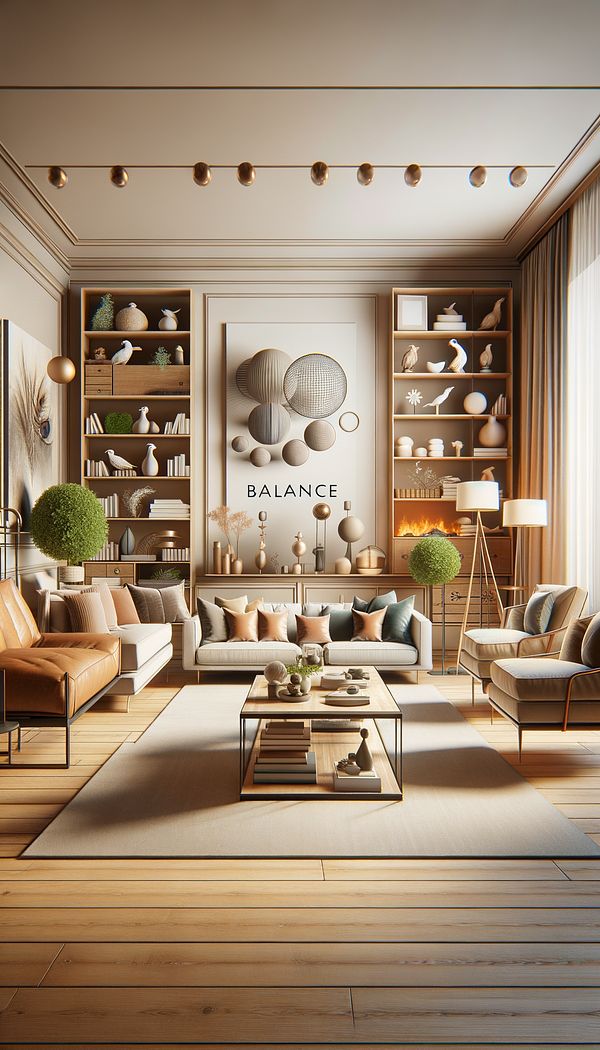What is Balance?
Balance in interior design refers to the distribution of visual weight in a space.
Description
Balance is a fundamental principle in interior design that ensures a room feels harmoniously arranged and visually pleasing. It is achieved when the elements of a room, such as furniture, color, and texture, are distributed in a way that creates a sense of equilibrium. Balance can make a room feel more comfortable, inviting, and stable, enhancing the overall aesthetic and functionality of the space.
There are three main types of balance: symmetrical, asymmetrical, and radial. Symmetrical balance is achieved when elements are mirrored on either side of a central axis, creating a mirror image. Asymmetrical balance, on the other hand, involves different elements that have equal visual weight but are not identical, providing a more relaxed and dynamic feel. Radial balance occurs when elements radiate from a central point, creating a circular flow around a focal point.
Understanding and applying the concept of balance is crucial for designers to create spaces that feel well-proportioned and cohesive. It requires a thoughtful consideration of the scale, proportion, and arrangement of elements within a space to achieve the desired level of visual harmony.
Usage
In a living room, for example, a large sofa on one side might be balanced by two armchairs and a side table on the opposite side, creating symmetrical balance. Similarly, in a dining room, a chandelier can act as the central point for radial balance, with furniture and decor arranged in a way that radiates outward. Asymmetrical balance might be observed in a bedroom where a tall floor lamp on one side of the bed is balanced by a cluster of smaller items, like a stack of books and a table lamp, on the other side.
FAQs
-
How is balance different from symmetry?
Balance is a broader concept that involves creating a sense of equilibrium through the distribution of visual weight, which can be achieved through symmetrical, asymmetrical, or radial arrangements. Symmetry is specifically about creating mirror-image compositions across a central axis.
-
Can balance be achieved with color?
Yes, color can play a significant role in achieving balance. The use of color can help distribute visual weight across a space, for instance, by balancing a bold wall color on one side of the room with similarly vibrant accessories or furniture pieces on the opposite side.
-
Is balance only important in large spaces?
No, balance is important in spaces of all sizes. In smaller spaces, achieving balance is particularly critical to avoid overcrowding or making the space feel lopsided. Thoughtful placement of furniture and decor can help achieve a visually harmonious space, regardless of its size.
Practical Application
When designing a room, consider the visual weight of each element and how it contributes to the room's overall balance. Start by identifying a focal point, then arrange furniture and decor to create a balanced composition. Experiment with different types of balance to find what best suits the space and the desired mood. The use of color, texture, and pattern can also help achieve balance, making the space feel well-rounded and visually cohesive.
-
Furniture Types599 articles
-
Space Planning & Layout134 articles
-
Decorating Principles & Elements330 articles
-
Color & Patterns154 articles
-
Textiles & Upholstery252 articles
-
LayeringLayering in interior design is the process of adding multiple elements together to create depth, interest, and balance within a space.
-
StrippingStripping in interior design refers to the process of removing layers of paint, wallpaper, varnish, or other coatings from surfaces.
-
ChambrayChambray is a lightweight cotton fabric with a plain weave and a slightly glossy surface.
-
AlignmentAlignment in interior design refers to the arrangement of elements in a way that creates a line or row, forming a visual connection.
-
Tapered LegA Tapered Leg is a furniture leg that becomes progressively narrower towards the bottom.
